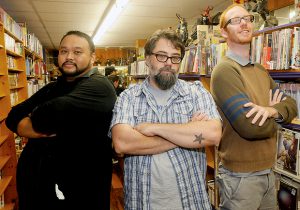
Toronto a hotbed for graphic novel and comic book talent
Conor McCreery, co-creator of graphic novel Kill Shakespeare, says he senses a slight prejudice floating beneath the surface of the arts community.
In a previous interview, he alluded to how comic book artists, writers and other imaginative inkwells are ostracized by the fact their illustrated stories are considered child’s play by those outside the “fanboy ghetto”.
“It always frustrates me a little bit, especially here in Canada where we do such a good job of bemoaning our lack of world leaders that we actually have, quietly in our midst, a golden age of talent that may not be seen again,” he said. “Part of it is because of the prejudice against the medium itself.”
When approached again to explain his frustration, McCreery is candid, sharing his thoughts on a mainstream misunderstanding that all of comics are one tight-clad genre.
“Part of the issue comes from the industry’s outreach,” he said. “Publishers don’t advertise like books do.”
Still, once graphic novels like History of Violence, Road to Perdition and Watchmen get adapted to the big screen, the interest in the comic book world jumps out of those aforementioned ghettos.
McCreery started on his way into the comic book world with his own Kill Shakespeare story in 2007, but before that time he worked with George Zotti at one of Toronto’s more popular comic book shops, Silver Snail.
Zotti admits there’s some apathy, pointing to the absence of well-known artist David Finch at Toronto comicons.
“It’s just because there’s no draw,” he said, adding there is a plethora of Canadian talent in the ranks of Marvel and DC that call Toronto home.
Including current Flash lead, Francis Manapul, Animal Man relauncher Jeff Lemire, Eisner-award winner Darwyn Cooke and artist Marcus To.
“Slowly over years and years, you know something like the Watchmen, brings people who are literary into the comic book world,” Zotti said, adding he always gets a raised eyebrow when he mentions movies’ graphic novel origins.
“I’ve told tons of people, ‘You know (Road to Perdition) was a comic,’ and they’re like, ‘What? I though comic books were only superheroes.’ ”
Comic book artist Marvin Law isn’t fazed by Toronto not getting it’s proper dues to artists, or whether the mainstream artists still look down on comic books as being either for children, or men drawing pictures of their perfect woman.
“It’s a weird thing because Toronto isn’t as big as being California and New York,” Law said. “It doesn’t get the press because, I don’t know, either we’re too humble or people don’t recognize Toronto is such a hotbed or has such great talent up here.”
Though Hogtown is coming into its own as Zotti admitted, Law said it never left.
“For a while there, Toronto used to be the beating heart of comics,” he said. “We used to have companies like Dreamwave Productions, Udon Entertainment, Bright Anvil Studios.
“We had all these different places with different groups of people who were producing good quality stuff,” he added. “I’ve seen any number of names come through the door at Bright Anvil Studios.”
Still, whether or not the city’s artists who flood the AGO for gala events pay credence to the graphic novel world, or until the Canadian literati nominate a comic book for a Giller, means nothing to Zotti, Law and McCreery.
“Recently talking with our main distributor, Diamond Comics, they told us Toronto is number 2 when it comes to the most comic book stores in a given geographical area, outside of New York,” Zotti said. “So, whether or not there’s a level of respect or not, obviously there’s lots of people buying comics.
“That’s always encouraging.”
